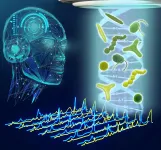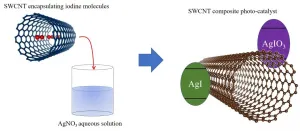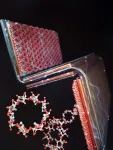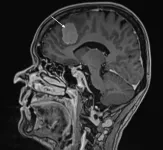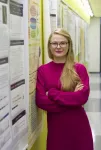(Press-News.org) A research team led by Professor Hongzhe SUN, Norman & Cecilia Yip Professor in Bioinorganic Chemistry and Chair Professor from Research Divison for Chemistry and Department of Chemistry, Faculty of Science, in collaboration with Dr Richard Yi-Ysun KAO, Associate Professor from the Department of Microbiology, Li Ka Shing Faculty of Medicine, and Dr Aixin YAN, Associate Professor from School of Biological Sciences, the University of Hong Kong (HKU), discovers that silver (Ag)-based antimicrobials can effectively combat antibiotic resistant Staphylococcus aureus by targeting multiple biological pathways via functional disruption of key proteins and can be further exploited to enhance the efficacy of conventional antibiotics as well as to resensitise methicillin-resistant Staphylococcus aureus (MRSA) to antibiotics.
The study resolves the long-standing question of the molecular targets of silver in Staphylococcus aureus and offers insights into the sustainable bacterial susceptibility of silver, providing a new approach for combating antimicrobial resistance. The ground-breaking findings are now published in a leading multidisciplinary science journal, Nature Communications.
Background
Antibiotics are medicines designed to kill bacteria and treat bacterial infections. Antibiotic resistance occurs when bacteria adjust in response to the misuse or overuse of these medicines, and it has become one of the biggest public health challenges in this era. At least 2.8 million people get an antibiotic-resistant infection annually in the US, and more than 35,000 people die from it.
Staphylococcus aureus, a round-shaped Gram-positive bacterium, is a dangerous and versatile pathogen for humans and is estimated that approximately 30% of the human population are asymptomatic nasal and long-term carriers. Staphylococcus is the causative agent of a variety of diseases, such as skin infection, food poisoning, bone/joint infection, and bacteremia, ranging from subacute superficial skin infection to life-threatening septicemia. The rise in incidence has been accompanied by an increase in antibiotic-resistant strains, especially MRSA. Moreover, the outbreak of the Coronavirus Disease 2019 (COVID-19) pandemic may further increase antimicrobial resistance due to the heavy use of antibiotics to treat patients infected with Severe Acute Respiratory Syndrome Coronavirus 2 (SARS-COV-2). Given the rapid emergence of drug-resistant Staphylococcus aureus but a lack of antibiotic-development pipeline, alternative strategies are urgently needed to combat antibiotic-resistant Staphylococcus aureus.
Key findings
Metal ions have been historically used as antimicrobial agents owing to their inherent broad-spectrum antimicrobial properties and less chance of resistance. There is a growing interest in revitalising metal-based compounds as promising alternatives to tackle the antimicrobial resistance crisis. Silver ions (Ag+) and silver nanoparticles (AgNPs) have been used as antimicrobial agents for centuries and are still being widely used in the healthcare and food industry. Previously, the team has built a technical platform named LC-GE-ICP-MS to systematically identify Ag+-proteome in Escherichia coli and developed a strategy named metabolome reprogramming to enhance the efficacy of antibacterial metallodrugs (PLoS Biol., 2019, 17, e3000292; Chem. Sci., 2019, 10, 7193-7199; Chem. Sci., 2020, 11, 11714-11719).
In this study, using the customised approach of LC-GE-ICP-MS, the team successfully separated and identified 38 authentic Ag+-binding proteins (Ag+-proteome) in Staphylococcus aureus at the whole-cell scale. In combination with bioinformatics analysis and systematic biochemical characterisation, they demonstrate that Ag+ exploits a shotgun action through targeting multiple proteins, thus interfering with multiple pathways, including glycolysis, oxidative pentose phosphate pathway (oxPPP), and reactive oxygen species (ROS) stress defence system, to exert its bactericidal effect against Staphylococcus aureus. Further studies unveiled that oxPPP served as a vital pathway targeted by Ag+ in Staphylococcus aureus, with 6PGDH identified as the key enzyme involved in the inhibitory effects of Ag+ against Staphylococcus aureus. They resolved the first crystal structures of 6PGDH from Staphylococcus aureus both in substrate-bound and Ag-bound forms and revealed that Ag+ abolished the enzymatic activity of 6PGDH through targeting Histidine 185 in the active site and morphing its catalytic pocket. This study resolves the long-standing question on the molecular targets and mode of action of silver against Staphylococcus aureus. Such a unique mode of action of silver via targeting multiple pathways confers the inability to select silver-resistant Staphylococcus aureus and endows it with the sustainable efficacy against Staphylococcus aureus.
Based on the uncovered molecular mechanism, they further demonstrate that Ag+/AgNP can potentiate the efficacy of a broad range of antibiotics, resensitise MRSA to antibiotics, and slow down the evolution of antibiotic resistance in Staphylococcus aureus. Therefore, a combination of antibiotics with silver or other metal-based compounds or nanomaterials could serve as a promising strategy to suppress the selection effects of antibiotics, thus preventing the occurrence of primary antibiotic resistance and extending the lifespan of conventional antibiotics to relieve the current crisis of antibiotic resistance.
INFORMATION:
About the research team
The research was conducted by a team led by Professor Hongzhe SUN, Norman & Cecilia Yip Professor in Bioinorganic Chemistry and Chair Professor of Department of Chemistry. Dr Haibo WANG is the first author. Other scientists contributing to the research include Dr Richard Yi-Ysun KAO, Associate Professor (Microbiology), Dr Aixin YAN, Associate Professor (Biological Sciences), Dr Hongyan LI, Senior Research Assistant (Chemistry), Dr Minji WANG, Associate Professor (Chemistry, East China Normal University), Dr Xiaohan XU, PhD student (Chemistry), Dr Peng GAO, Research Assistant Professor (Microbiology), Dr Zeling XU, Associate Professor (South China Agricultural University), and Dr Qi ZHANG (Chemistry).
The work was supported by the Research Grants Council of Hong Kong, Health and Medical Research Fund and Seed Fund for Basic Research.
About Professor Hongzhe SUN
Professor Hongzhe SUN is the Norman & Cecilia Yip Professor in Bioinorganic Chemistry and Chair Professor from Research Division for Chemistry and Department of Chemistry at HKU. His research focuses on metalloproteins, the discovery of antimicrobial agents, and inorganic chemical biology. Professor Sun has published a series of well-recognised work in overcoming antimicrobial resistance against superbugs, developing anti-coronavirus agent, and understanding the functions of metalloproteins.
More information about Professor Hongzhe SUN and his research group can be found from their group's webpage: http://www.bioinorg-chem.hku.hk
About the research paper: https://www.nature.com/articles/s41467-021-23659-y
Microalgae are "simple" organisms of single cells, yet they pack a mighty potential punch when it comes to helping humanity achieve carbon neutrality, according to researchers from the Qingdao Institute of Bioenergy and Bioprocess Technology (QIBEBT) of the Chinese Academy of Sciences (CAS). Their metabolic activities play fundamental roles in global carbon cycling and convert carbon dioxide into a wide variety of high-value macromolecules.
Now, the QIBEBT researchers have developed a way to rapidly determine exactly which microalgae -- out of the millions of variations -- can most readily convert carbon dioxide into valuable compounds that can be used for fuels, food and drugs. They published ...
Fragrances are functional molecules with a pleasant scent that are widely used in aqueous products (cosmetics and detergents) and on surfaces such as textiles, leather and wallpaper. However, maintaining gentle and continuous scent on these items is an ongoing challenge in the field of flavours and fragrances.
Profragrances are delivery systems used to control the release of the volatile compounds in fragrances. They have fragile chemical bonds that can be stimulated by ambient conditions such as light, temperature, pH value and even oxygen. Drawing on these molecular profragrances, ...
Carbon dioxide (CO2) emissions from human activities have risen drastically over the last century and a half and are seen as the primary cause of global warming and abnormal weather patterns. So, there has been considerable research focus, in a number of fields, on lowering our CO2 emissions and its atmospheric levels. One promising strategy is to chemically break down, or 'reduce,' CO2 using photocatalysts--compounds that absorb light energy and provide it to reactions, speeding them up. With this strategy, the solar powered reduction of CO2, where no other artificial source of energy is used, becomes ...
Scientists have used a compound made from a starch derivative and baking soda to help convert mechanical to electrical energy. The approach, developed by scientists at Daegu Gyeongbuk Institute of Technology (DGIST), with colleagues in Korea and India, is cost-effective and biocompatible, and can help charge low-energy electronics like calculators and watches. The details were published in the journal Advanced Functional Materials.
"Triboelectric nanogenerators harvest mechanical energy and convert it into an electric current," explains DGIST robotics engineer Hoe Joon Kim. "But many of the materials used in these devices are considered a biohazard and are not suitable for wearable ...
Meningiomas, which originate in the meninges surrounding the brain, are the most common type of benign brain tumours. The primary treatment for meningiomas is neurosurgery. Since the risks associated with surgical treatment increase as people get older and develop other diseases, over 80-year-old patients with brain tumours are not operated on almost anywhere in the world.
In Finland, the life expectancy and functional capacity of the elderly population have improved in recent decades, while the number of elderly brain tumour patients who are in good condition is continuously growing. This is why surgeries have increased in prevalence at the Neurosurgery Clinic of the Helsinki University Hospital in the treatment of elderly patients who have lost their ...
Tropical cyclones (TCs) can bring strong wind, heavy rain, and storm surge. Meteorologists are concerned that the effects of global warming may change how these storms impact humans.
Scientists use global climate models (GCMs) in climate change studies to simulate future changes in temperature, precipitation, etc. However, due to their coarse resolutions, many models cannot properly simulate small-scale weather and climate systems like TCs, which means that they cannot capture all the dynamic processes within a TC.
A study led by Prof. Gao Xuejie from the Institute ...
Dissatisfaction with married life raises the risk of dying from a cerebrovascular accident: A new Tel Aviv University study reveals that perceiving marriage as unsuccessful is a significant predictor of death from a CVA and premature death among men, no less that well-known risk factors such as smoking and lack of physical activity. The study was based on extensive health data from more than 30 years of research that tracked the deaths of 10,000 Israeli men.
The study was led by researchers from the School of Public Health at the Sackler Faculty of Medicine, Tel Aviv University: Prof. Uri Goldbort from the Department of Epidemiology and Preventive Medicine, who initiated and managed the long-term study; Dr. Shahar Lev-Ari, the head ...
Research has found that training stroke survivors to walk at a faster speed during recovery can help improve the brain function that enables people to walk and perform another task simultaneously, known as dual-task walking. The research, led by academics at Oxford Brookes University, was funded by the Stroke Association.
People who've had a stroke often struggle to walk and do tasks that involve thinking at the same time, for example, activities such as walking and holding a conversation, or planning what to do next. To effectively walk in the community, cognitive effort is needed to navigate safely and deal with distractions. Many people fail to regain this ability after a stroke.
Dual-task ...
Vitamin B12 is essential for proper functioning of the nervous system and blood cells and also plays an important role in DNA synthesis in all our cells. Vitamin B12 deficiency causes fatigue, muscle weakness, headaches, and sometimes even serious neurological symptoms. Usually, the necessary amounts of B12 are absorbed from food in our digestive tract; however, in 0.1-2% of individuals, the epithelial lining of the stomach fails to produce a glycoprotein intrinsic factor that is needed for proper absorption of B12. This leads to vitamin B12 deficiency and a certain type of anemia called pernicious anemia. Pernicious ...
The research team used data from world renowned health study Children of the 90s, to answer three research questions:
Is school enjoyment patterned by biological sex at birth, socioeconomic background of cognition?
How does school enjoyment relate to GCSE achievement?
Does school enjoyment relate to social or sex differences in GCSE achievement?
The team found that pupil's school enjoyment measured at six years old is patterned by their sex and cognitive ability but not their family's socioeconomic background. For example, girls were twice as likely to report enjoying school than boys. School enjoyment strongly related to GCSE achievement at age 16 even after consideration of their socioeconomic background ...

